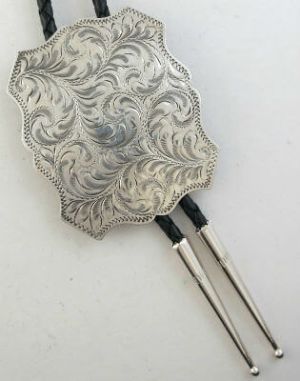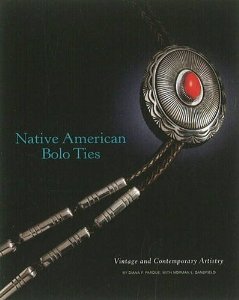Affiliate Disclaimer: We work to provide bolo ties and locate merchants who sell the products you are looking for. If you make a purchase from any of the merchants we endorse, we will earn a small commission at no additional cost to you. Thank you for your support!
Western Bolo Ties worn by cowboys and western country singers for years
 Western Bolo Ties are probably the most recognizable. Many cowboys and western country singers have worn them for years. No wardrobe is complete without a classic western bolo tie. Western wear and bolo ties were brought to the attention of a wider audience by the bolo tie associated with film characters and stars of the early period of television.
Western Bolo Ties are probably the most recognizable. Many cowboys and western country singers have worn them for years. No wardrobe is complete without a classic western bolo tie. Western wear and bolo ties were brought to the attention of a wider audience by the bolo tie associated with film characters and stars of the early period of television.Such is the story of the earliest bolo (or bola) ties, which starts around 1947. These early pieces are silver isosceles, trapezoid or keystone-shaped, about one inch high. They are all unsigned, as was most Native American art in the 1940s. Some are stamped "sterling." However, there is no documentation for any of them.
Printed documentation for bolo ties doesn't start until 1953.The earliest bolo-style tie appearing in a Western wear catalog, in 1953-1954, was listed as "New "String-A-Long' Western Tie; Rayon cord available in 7 colors. Leather slide with colored jewel to match braiding, metal tips." Western Ranchman Outfitters, Cheyenne, Wyoming, Catalog number 31, page 49.
The history of bolo ties is an area of heated debate amid the world of men's fashion. The fact is, men around the world have adopted the look and want to call it their own, whether they're Navajo Indians of the American southwest, Argentinean cowboys or rock and roll bad boy Jon Bon Jovi. Sort through this tangled web of stories and legends surrounding bolo ties to determine who can legitimately claim its invention.
Bola Bill Kramer wrote "'Bola Tie: New Symbol of the West" in 1978. In his tome, he shares what he considers the authoritative version of the origins of the bolo tie. He chronicles the story of Victor E. Cedarstaff, a silversmith who lived in Arizona in the 1940s. Cedarstaff and some cohorts were chasing after wild horses when Cedarstaff's silver-bordered hatband slipped off, making his hat fly away as well. He caught up with his hat band and slipped it over his neck for safekeeping. His friends noticed his look and complimented his new tie. Cedarstaff decided to create a line of ties inspired by the incident. He braided leather, placed silver tips on the ends to keep them from fraying and then joined the strands with a turquoise stone to be used as an adjustable clasp. He applied for a patent, calling his creation the bola tie, named after the boleadoras cords worn by Argentine cowboys.

Western Bolo Ties for Sale
References
The Early Days of Bolo TiesThe History of Bolo Ties
The Origin of the Bolo Tie -- Bolo Tie Shop
Ethnic Dress in the United States: A Cultural Encyclopedia









